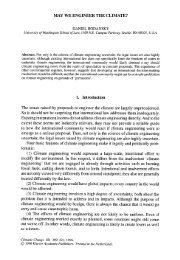ThorEA - Towards an Alternative Nuclear Future.pdf
ThorEA - Towards an Alternative Nuclear Future.pdf
ThorEA - Towards an Alternative Nuclear Future.pdf
You also want an ePaper? Increase the reach of your titles
YUMPU automatically turns print PDFs into web optimized ePapers that Google loves.
1.5 The potential global market for thorium-fuelled<br />
ADSR systems<br />
The <strong>an</strong>alysis of the current nuclear market size <strong>an</strong>d its future<br />
prospects offers a valuable insight on the market potential<br />
for thorium-fuelled ADSRs (see also the five forces <strong>an</strong>alysis<br />
in Appendix IV). There are currently 436 nuclear reactors in<br />
operation worldwide, generating a total of 372 GWe, i.e. 15%<br />
of the electricity consumed globally. In its World Energy<br />
Outlook 2006 (IEA, 2007), the IEA forecasts <strong>an</strong> average 2.6%<br />
yearly increase in global electricity dem<strong>an</strong>d (4). In the IEA<br />
Electricity production/consumption (TWh/yr)<br />
40,000<br />
35,000<br />
30,000<br />
25,000<br />
20,000<br />
15,000<br />
10,000<br />
5,000<br />
0<br />
World electricity consumption<br />
Potential exp<strong>an</strong>sion scenario<br />
<strong>Nuclear</strong> production (IEA alternative scenario)<br />
<strong>Nuclear</strong> production (IEA reference scenario)<br />
reference scenario, nuclear electricity production increases<br />
<strong>an</strong> average of 0.7% per year until 2030. The IEA alternative<br />
scenario foresees a growth of 2.3% in nuclear energy<br />
production. These scenarios are presented in the Figure 4<br />
below, which also includes a potential exp<strong>an</strong>sion scenario<br />
in which global nuclear electricity share increases from 15%<br />
to 22% (current share in OECD countries) from 2007 to 2030,<br />
with <strong>an</strong> average growth of 4% per year.<br />
1990 1995 2000 2005 2010 2015 2020 2025 2030<br />
Figure 4. Evolution of the global electricity dem<strong>an</strong>d <strong>an</strong>d share of nuclear production for the three different IEA scenarios.<br />
These three growth scenarios would entail <strong>an</strong> increase in<br />
the nuclear energy production of 500, 2,000 <strong>an</strong>d 4,800 TWh,<br />
respectively. Such <strong>an</strong> increase implies the commissioning of<br />
65, 260 <strong>an</strong>d 610 GWe, at 85% availability. The following table,<br />
Yearly growth<br />
Year<br />
Increase in electricity<br />
production from nuclear<br />
by 2030 (TWh)<br />
which summarises these scenarios, clearly indicates the<br />
enormous potential market for ADSR systems (~£100b),<br />
even if only 30% of the dem<strong>an</strong>d is met by ADSRs.<br />
New installed nuclear<br />
capacity by 2030 (GWe),<br />
85% availability<br />
ADSRs (600 MWe)<br />
covering such dem<strong>an</strong>d<br />
Reference IEA 0.7% 500 68 114<br />
<strong>Alternative</strong> IEA 2.3% 2,000 275 458<br />
Potential exp<strong>an</strong>sion 4.0% 4,800 645 1,076<br />
A report prepared by: the thorium energy amplifier association 15



